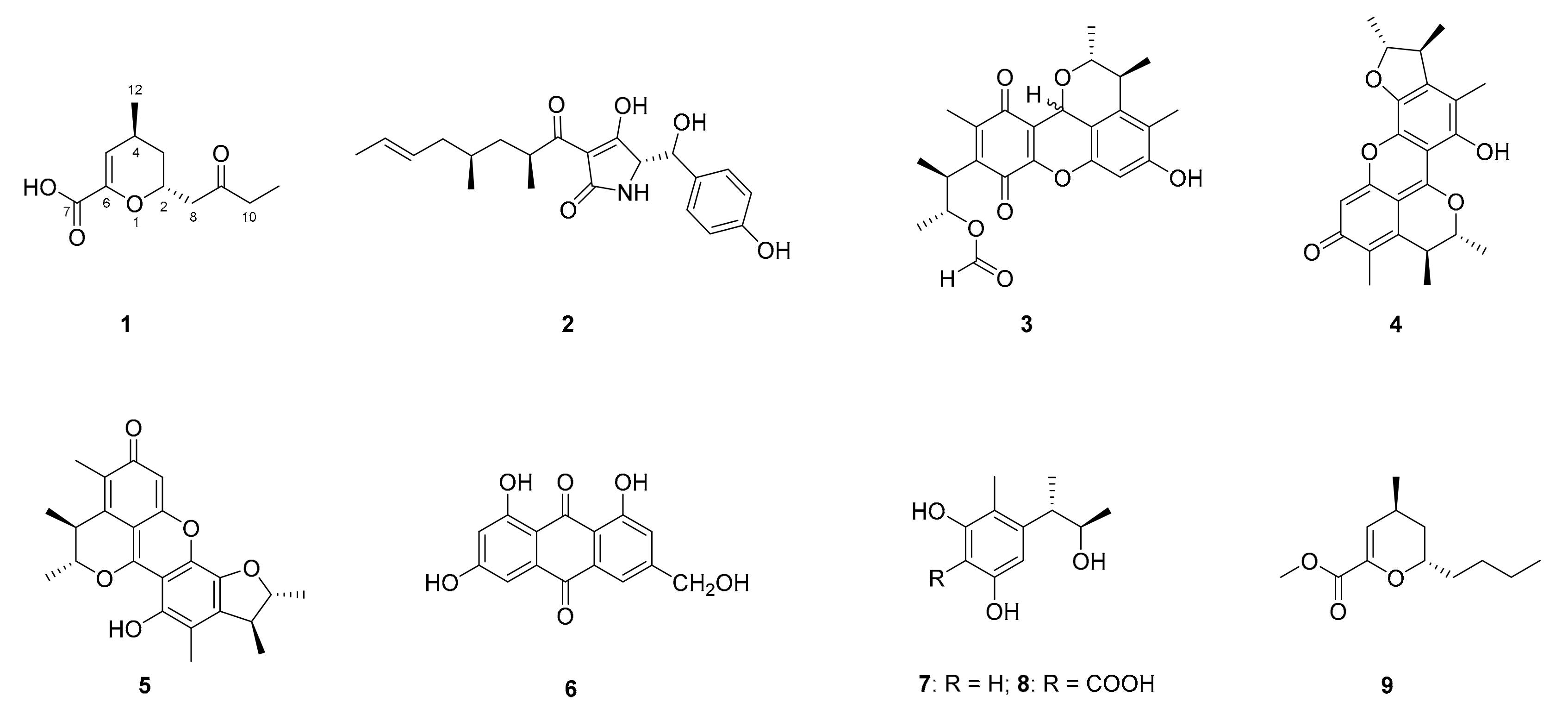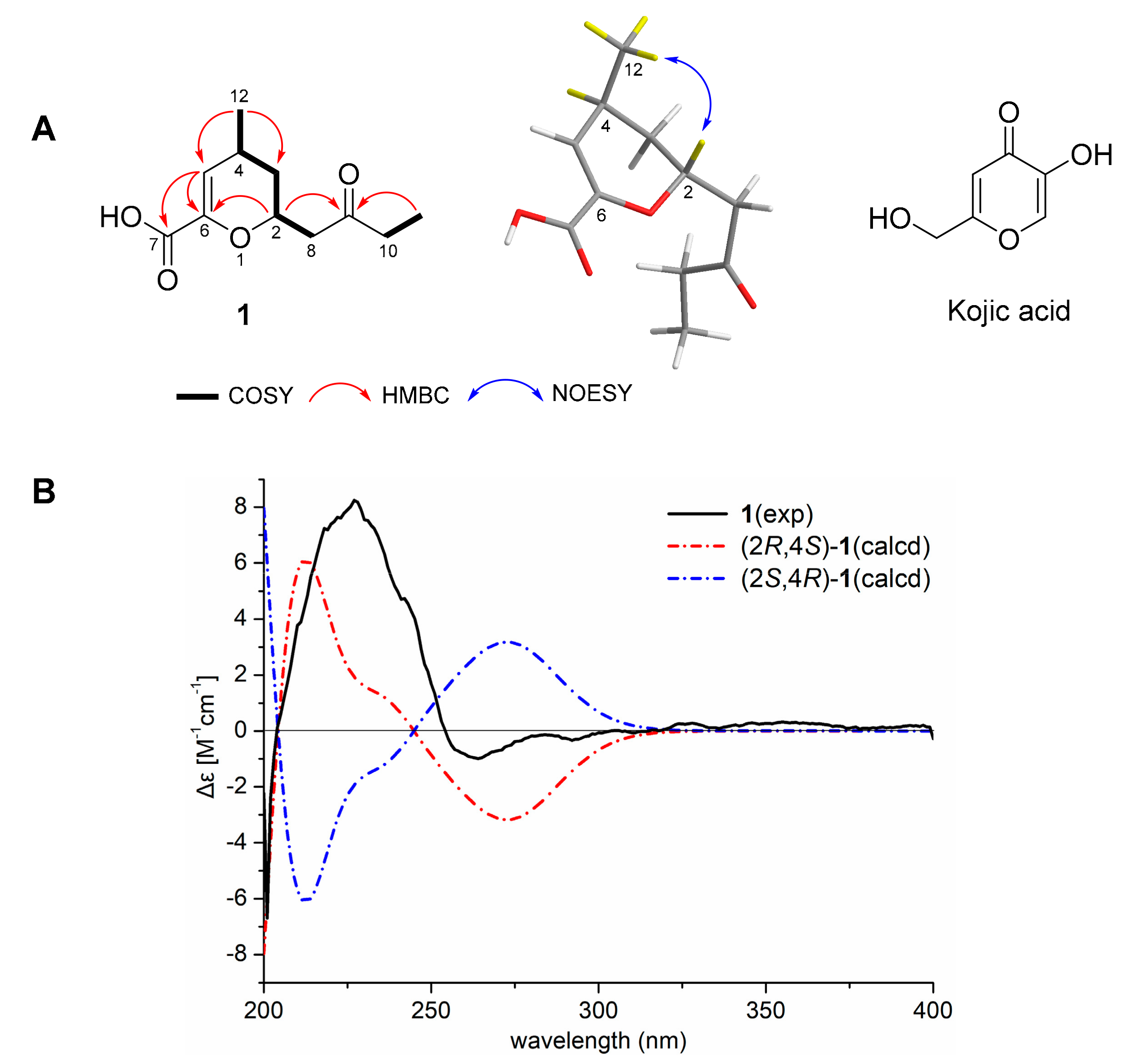Cylindromicin from Arctic-Derived Fungus Tolypocladium sp. SCSIO 40433
Abstract
1. Introduction
2. Results and Discussion
2.1. Strain Identification
2.2. Compound Isolation and Structure Elucidation
2.3. Bioactivity Evaluation of Compounds 1–8
2.4. Structure-Activity Comparsion of Cylindromicin (1) and Kojic Acid
3. Materials and Methods
3.1. General Experimental Procedures
3.2. Isolation and Identification of Strain SCSIO 40433
3.3. Fermentation and Extraction of Strain SCSIO 40433
3.4. Purification of the Compounds 1–8
3.5. Computational Method for ECD Prediction
3.6. Tyrosinase Inhibition Assay of Compounds 1–8
3.7. Antibacterial and Alpha-Glucosidase Inhibition Assay of Compounds 1–8
4. Conclusions
Supplementary Materials
Author Contributions
Funding
Institutional Review Board Statement
Informed Consent Statement
Data Availability Statement
Acknowledgments
Conflicts of Interest
Sample Availability
References
- Liu, J.T.; Lu, X.L.; Liu, X.Y.; Gao, Y.; Hu, B.; Jiao, B.H.; Zheng, H. Bioactive natural products from the antarctic and arctic organisms. Mini. Rev. Med. Chem. 2013, 13, 617–626. [Google Scholar] [CrossRef]
- Zhang, L.; Ruan, C.; Peng, F.; Deng, Z.; Hong, K. Streptomyces arcticus sp. nov. isolated from frozen soil. Int. J. Syst. Evol. Microbiol. 2016, 66, 1482–1487. [Google Scholar] [CrossRef] [PubMed]
- Dalsgaard, P.W.; Larsen, T.O.; Christophersen, C. Bioactive cyclic peptides from the psychrotolerant fungus Penicillium algidum. J. Antibiot. 2005, 58, 141–144. [Google Scholar] [CrossRef]
- Dickschat, J.S.; Helmke, E.; Schulz, S. Volatile organic compounds from arctic bacteria of the Cytophaga-Flavobacterium-Bacteroides group: A retrobiosynthetic approach in chemotaxonomic investigations. Chem. Biodivers. 2005, 2, 318–353. [Google Scholar] [CrossRef]
- Ma, H.G.; Liu, Q.; Zhu, G.L.; Liu, H.S.; Zhu, W.M. Marine natural products sourced from marine-derived Penicillium fungi. J. Asian Nat. Prod. Res. 2016, 18, 92–115. [Google Scholar] [CrossRef] [PubMed]
- Blunt, J.W.; Copp, B.R.; Keyzers, R.A.; Munro, M.H.G.; Prinsep, M.R. Marine natural products. Nat. Prod. Rep. 2017, 34, 235–294. [Google Scholar] [CrossRef] [PubMed]
- Blunt, J.W.; Carroll, A.R.; Copp, B.R.; Davis, R.A.; Keyzers, R.A.; Prinsep, M.R. Marine natural products. Nat. Prod. Rep. 2018, 35, 8–53. [Google Scholar] [CrossRef]
- Carroll, A.R.; Copp, B.R.; Davis, R.A.; Keyzers, R.A.; Prinsep, M.R. Marine natural products. Nat. Prod. Rep. 2019, 36, 122–173. [Google Scholar] [CrossRef]
- Carroll, A.R.; Copp, B.R.; Davis, R.A.; Keyzers, R.A.; Prinsep, M.R. Marine natural products. Nat. Prod. Rep. 2020, 37, 175–223. [Google Scholar] [CrossRef]
- Wilson, Z.E.; Brimble, M.A. Molecules derived from the extremes of life. Nat. Prod. Rep. 2009, 26, 44–71. [Google Scholar] [CrossRef]
- Wilson, Z.E.; Brimble, M.A. Molecules derived from the extremes of life: A decade later. Nat. Prod. Rep. 2021, 38, 24–82. [Google Scholar] [CrossRef]
- Sun, C.X.; Zhang, Z.P.; Ren, Z.L.; Yu, L.; Zhou, H.; Han, Y.X.; Shah, M.; Che, Q.; Zhang, G.J.; Li, D.H.; et al. Antibacterial cyclic tripeptides from Antarctica-sponge-derived fungus Aspergillus insulicola HDN151418. Mar. Drugs 2020, 18, 532. [Google Scholar] [CrossRef]
- Abbas, S.; Kelly, M.; Bowling, J.; Sims, J.; Waters, A.; Hamann, M. Advancement into the Arctic region for bioactive sponge secondary metabolites. Mar. Drugs 2011, 9, 2423–2437. [Google Scholar] [CrossRef]
- Yu, H.B.; Wang, X.L.; Xu, W.H.; Zhang, Y.X.; Qian, Y.S.; Zhang, J.P.; Lu, X.L.; Liu, X.Y. Eutypellenoids A(-)C, new pimarane diterpenes from the Arctic fungus Eutypella sp. D-1. Mar. Drugs 2018, 16, 284. [Google Scholar] [CrossRef]
- Zhang, Y.X.; Yu, H.B.; Xu, W.H.; Hu, B.; Guild, A.; Zhang, J.P.; Lu, X.L.; Liu, X.Y.; Jiao, B.H. Eutypellacytosporins A-D, meroterpenoids from the Arctic fungus Eutypella sp. D-1. J. Nat. Prod. 2019, 82, 3089–3095. [Google Scholar] [CrossRef]
- Lu, X.L.; Liu, J.T.; Liu, X.Y.; Gao, Y.; Zhang, J.; Jiao, B.H.; Zheng, H. Pimarane diterpenes from the Arctic fungus Eutypella sp. D-1. J. Antibiot. 2014, 67, 171–174. [Google Scholar] [CrossRef] [PubMed]
- Wang, X.; Sun, K.; Wang, B. Bioactive pimarane diterpenes from the Arctic fungus Eutypella sp. D-1. Chem. Biodivers. 2018, 15, e1700501. [Google Scholar] [CrossRef] [PubMed]
- Corinaldesi, C.; Barone, G.; Marcellini, F.; Dell’Anno, A.; Danovaro, R. Marine microbial-derived molecules and their potential use in cosmeceutical and cosmetic products. Mar. Drugs 2017, 15, 118. [Google Scholar] [CrossRef]
- Friedemann, T.E. Chemical and physiological properties of kojic acid. Science 1934, 80, 34–35. [Google Scholar] [CrossRef]
- Gould, B.S. The metabolism of Aspergillus tamarii Kita. kojic acid production. Biochem. J. 1938, 32, 797–802. [Google Scholar] [CrossRef] [PubMed]
- Hasil, A.; Mehmood, A.; Noureen, S.; Ahmed, M. Experimental and theoretical charge density analysis of skin whitening agent kojic acid. J. Mol. Struct. 2020, 1216, 128295. [Google Scholar] [CrossRef]
- Karakaya, G.; Ture, A.; Ercan, A.; Oncul, S.; Aytemir, M.D. Synthesis, computational molecular docking analysis and effectiveness on tyrosinase inhibition of kojic acid derivatives. Bioorg. Chem. 2019, 88, 102950. [Google Scholar] [CrossRef]
- Singh, L.R.; Chen, Y.L.; Xie, Y.Y.; Xia, W.; Gong, X.W.; Hider, R.C.; Zhou, T. Functionality study of chalcone-hydroxypyridinone hybrids as tyrosinase inhibitors and influence on anti-tyrosinase activity. J. Enzym. Inhib. Med. Ch. 2020, 35, 1562–1567. [Google Scholar] [CrossRef]
- Sakuma, K.; Ogawa, M.; Sugibayashi, K.; Yamada, K.; Yamamoto, K. Relationship between tyrosinase inhibitory action and oxidation-reduction potential of cosmetic whitening ingredients and phenol derivatives. Arch. Pharm. Res. 1999, 22, 335–339. [Google Scholar] [CrossRef]
- Ashraf, Z.; Rafiq, M.; Seo, S.Y.; Babar, M.M.; Zaidi, N.U. Synthesis, kinetic mechanism and docking studies of vanillin derivatives as inhibitors of mushroom tyrosinase. Bioorg. Med. Chem. 2015, 23, 5870–5880. [Google Scholar] [CrossRef]
- Zolghadri, S.; Bahrami, A.; Hassan Khan, M.T.; Munoz-Munoz, J.; Garcia-Molina, F.; Garcia-Canovas, F.; Saboury, A.A. A comprehensive review on tyrosinase inhibitors. J. Enzym. Inhib. Med. Ch. 2019, 34, 279–309. [Google Scholar] [CrossRef]
- Chang, T.S. An updated review of tyrosinase inhibitors. Int. J. Mol. Sci. 2009, 10, 2440–2475. [Google Scholar] [CrossRef]
- Bovio, E.; Garzoli, L.; Poli, A.; Luganini, A.; Villa, P.; Musumeci, R.; McCormack, G.P.; Cocuzza, C.E.; Gribaudo, G.; Mehiri, M.; et al. Marine fungi from the sponge Grantia compressa: Biodiversity, chemodiversity, and biotechnological potential. Mar. Drugs 2019, 17, 220. [Google Scholar] [CrossRef]
- Montalva, C.; Silva, J.J.; Rocha, L.F.N.; Luz, C.; Humber, R.A. Characterization of Tolypocladium cylindrosporum (Hypocreales, Ophiocordycipitaceae) isolates from Brazil and their efficacy against Aedes aegypti (Diptera, Culicidae). J. Appl. Microbiol. 2019, 126, 266–276. [Google Scholar] [CrossRef]
- Sera, A.; Ohara, M.; Yamada, H.; Egashira, E.; Ueda, N.; Setsune, J. Lewis acid-catalyzed hetero-Diels-Alder reactions of methyl 2-oxo-3-alkenoates with alkenes. B. Chem. Soc. Jpn. 1994, 67, 1912–1917. [Google Scholar] [CrossRef]
- Fukuda, T.; Sudoh, Y.; Tsuchiya, Y.; Okuda, T.; Matsuura, N.; Motojima, A.; Oikawa, T.; Igarashi, Y. Tolypoalbin, a new tetramic acid from Tolypocladium album TAMA 479. J. Antibiot. 2015, 68, 399–402. [Google Scholar] [CrossRef]
- Wang, W.; Liao, Y.; Zhang, B.; Gao, M.; Ke, W.; Li, F.; Shao, Z. Citrinin monomer and dimer derivatives with antibacterial and cytotoxic activities isolated from the deep sea-derived fungus Penicillium citrinum NLG-S01-P1. Mar. Drugs 2019, 17, 46. [Google Scholar] [CrossRef] [PubMed]
- Dame, Z.T.; Suwannarach, N.; Lumyong, S.; Laatsch, H. A new citrinin dimer isolated from Aspergillus terreus strainZDF21. Nat. Prod. Commun. 2015, 10, 623–624. [Google Scholar] [CrossRef]
- Wakana, D.; Hosoe, T.; Itabashi, T.; Okada, K.; Takaki, G.M.D.; Yaguchi, T.; Fukushima, K.; Kawai, K. New citrinin derivatives isolated from Penicillium citrinum. J. Nat. Med. 2006, 60, 279–284. [Google Scholar] [CrossRef]
- Yang, X.W.; Gu, Z.M.; Ma, C.M.; Hattori, M.; Namba, T. A new indole derivative isolated from the root of tuber fleeceflower ( Polygonum multiflorum). Chin. Tradit. Herb. Drugs 1998, 29, 5–11. [Google Scholar]
- Han, Z.; Mei, W.L.; Zhao, Y.X.; Deng, Y.Y.; Dai, H.F. A new cytotoxic isocoumarin from endophytic fungus Penicillium sp. 091402 of the mangrove plant Bruguiera sexangula. Chem. Nat. Compd. 2009, 45, 805–807. [Google Scholar] [CrossRef]
- Rodel, T.; Gerlach, H. Enantioselective synthesis of the polyketide antibiotic (3R,4S)-(−)-citrinin. Liebigs Ann. 1995, 5, 885–888. [Google Scholar] [CrossRef]
- Li, X.; Kim, M.K.; Lee, U.; Kim, S.K.; Kang, J.S.; Choi, H.D.; Son, B.W. Myrothenones A and B, cyclopentenone derivatives with tyrosinase inhibitory activity from the marine-derived fungus Myrothecium sp. Chem. Pharm. Bull. 2005, 53, 453–455. [Google Scholar] [CrossRef]
- Ishihara, A.; Ide, Y.; Bito, T.; Ube, N.; Endo, N.; Sotome, K.; Maekawa, N.; Ueno, K.; Nakagiri, A. Novel tyrosinase inhibitors from liquid culture of Neolentinus lepideus. Biosci. Biotech. Bioch. 2018, 82, 22–30. [Google Scholar] [CrossRef]
- Tamura, K.; Nei, M.; Kumar, S. Prospects for inferring very large phylogenies by using the neighbor-joining method. Proc. Natl. Acad. Sci. U.S.A 2004, 101, 11030–11035. [Google Scholar] [CrossRef] [PubMed]
- Kurtán, T.; Antus, S.; Pescitelli, G.B. Comprehensive Chiroptical Spectroscopy: Applications in Stereochemical Analysis of Synthetic Compounds, Natural Products, and Biomolecules, 1st ed.; John Wiley & Sons, Inc.: Hoboken, NJ, USA, 2012; Volume 2, pp. 73–114. [Google Scholar]
- Frisch, M.J.T.G.W.; Schlegel, H.B.; Scuseria, G.E.; Robb, M.A.; Cheeseman, J.R.; Scalmani, G.; Barone, V.; Mennucci, B.; Petersson, G.A. Gaussian 09, Revision A.02; Gaussian Inc.: Wallingford, CT, USA, 2009. [Google Scholar]
- Bruhn, T.; Schaumlöffel, A.; Hemberger, Y.; Bringmann, G. SpecDis: Quantifying the comparison of calculated and experimental electronic circular dichroism spectra. Chirality 2013, 25, 243–249. [Google Scholar] [CrossRef] [PubMed]
- Lu, R.; Liu, X.; Gao, S.; Zhang, W.; Peng, F.; Hu, F.; Huang, B.; Chen, L.; Bao, G.; Li, C.; et al. New tyrosinase inhibitors from Paecilomyces gunnii. J. Agric. Food Chem. 2014, 62, 11917–11923. [Google Scholar] [CrossRef] [PubMed]
- Clinical and Laboratory Standards Institute (CLSI). Seventeenth Informational Supplement; CLSI Document M100-S117; CLSI: Wayne, PA, USA, 2007. [Google Scholar]
- Li, T.Z.X.D.; Song, Y.W.; Liu, J.W. A microplate-based screening method for alpha-glucosidase inhibitors. Chin. J. Clin. Pharmacol. Ther. 2005, 10, 1128–1134. [Google Scholar]


| Carbon No. | δC, Type | δH (Multi, J in Hz) |
|---|---|---|
| 2 | 70.6, CH | 4.38 (m) |
| 3 | 37.5, CH2 | 1.60 (m), 1.70 (m) |
| 4 | 26.2, CH | 2.41 (m) |
| 5 | 117.1, CH | 6.02 (d, 4.2) |
| 6 | 144.6, C | |
| 7 | 166.9, C | |
| 8 | 47.5, CH2 | 2.64 (dd, 5.6,16.8); 2.93 (dd, 7.0,16.8) |
| 9 | 211.6, C | |
| 10 | 34.8, CH2 | 2.56 (m) |
| 11 | 7.8, CH3 | 1.03 (t, 7.0) |
| 12 | 22.0, CH3 | 1.11 (d, 7.0) |
| Concentrations | 1 | Kojic Acid |
|---|---|---|
| 10 μM | 0.62 ± 0.04% | 1.23 ± 0.06% |
| 20 μM | 7.41 ± 0.06% | 6.17 ± 0.09% |
| 40 μM | 23.4 ± 0.11% | 27.41 ± 0.09% |
Publisher’s Note: MDPI stays neutral with regard to jurisdictional claims in published maps and institutional affiliations. |
© 2021 by the authors. Licensee MDPI, Basel, Switzerland. This article is an open access article distributed under the terms and conditions of the Creative Commons Attribution (CC BY) license (http://creativecommons.org/licenses/by/4.0/).
Share and Cite
Khan, I.; Peng, J.; Fang, Z.; Liu, W.; Zhang, W.; Zhang, Q.; Ma, L.; Zhang, G.; Zhang, C.; Zhang, H. Cylindromicin from Arctic-Derived Fungus Tolypocladium sp. SCSIO 40433. Molecules 2021, 26, 1080. https://doi.org/10.3390/molecules26041080
Khan I, Peng J, Fang Z, Liu W, Zhang W, Zhang Q, Ma L, Zhang G, Zhang C, Zhang H. Cylindromicin from Arctic-Derived Fungus Tolypocladium sp. SCSIO 40433. Molecules. 2021; 26(4):1080. https://doi.org/10.3390/molecules26041080
Chicago/Turabian StyleKhan, Imran, Jing Peng, Zhuangjie Fang, Wei Liu, Wenjun Zhang, Qingbo Zhang, Liang Ma, Guangtao Zhang, Changsheng Zhang, and Haibo Zhang. 2021. "Cylindromicin from Arctic-Derived Fungus Tolypocladium sp. SCSIO 40433" Molecules 26, no. 4: 1080. https://doi.org/10.3390/molecules26041080
APA StyleKhan, I., Peng, J., Fang, Z., Liu, W., Zhang, W., Zhang, Q., Ma, L., Zhang, G., Zhang, C., & Zhang, H. (2021). Cylindromicin from Arctic-Derived Fungus Tolypocladium sp. SCSIO 40433. Molecules, 26(4), 1080. https://doi.org/10.3390/molecules26041080







